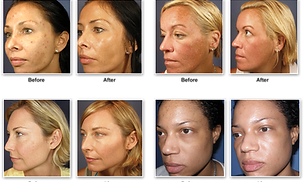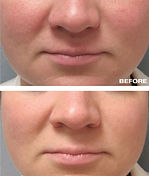

AESTHETIC PERMANENT BEAUTY
By Lena Jarborg
Permanent Make Up And Skin Care Clinic
CHEMICAL PEELS FOR EVERY COMPLEXION
.jpg)
.jpg)

.jpg)
ACNE - HYPER-PIGMENTATION - ROSACEA - REDNESS - SENSITIV SKIN - MELASMA


.jpg)




VI PEEL BODY PEELS IS FINALLY HERE!










Chemical peels are not all the same
There are different types of products that can be used and there's a big difference in how deeply the chemical that's being applied affects the skin. When people refer to chemical peels, there are three types: Light, Medium, and Deep. It's important to understand the difference between these types before choosing which one to use. Light chemical peels are the mildest and can be used to treat fine wrinkles, uneven skin tone, and acne.Medium chemical peels penetrate deeper and can be used to treat deep wrinkles, acne scars, and sun damage. Deep chemical peels are the strongest and penetrate the deepest layers of the skin. They're used to treat severe wrinkles, scars, and precancerous growths. It's important to consult with a dermatologist or skincare professional before choosing which type of chemical peel is right for you.
DEFINITION OF PEELS
Light chemical peel, also known as a "lunchtime peel". These peels require minimal downtime, with only redness lasting for 20 minutes to half an hour and possible dryness or flaking for a few days. The peels use mild acids such as glycolic, salicylic, kojic acid, and malic acid, making them effective for treating fine lines, wrinkles, large pores, and dark spots, while also helping to tighten the skin. Plus, if you have a big event coming up, a light chemical peel a few days before can give you stunning results for a refreshed, youthful glow.
Medium-depth chemical peels are a popular cosmetic treatment that use trichloroacetic acid at concentrations of 35 percent or less. These peels are usually performed by medical aestheticians or doctors, as they use a pure form of the acid that isn't neutralized. They're an effective treatment option for skin that requires significant color or texture correction, such as photodamage, sun spots, mild to moderate acne scars, crepey skin under the eyes, or dark circles. The peeling time for medium-depth peels is typically 5-7 days. If you're interested in exploring this treatment option, consult with your qualified medical Aesthetichian to determine if it's right for you.
If you are considering a Deep peel, it's important to understand that these treatments should only be done at a physician's office. Deep peels are typically considered to be 50-70%.
If you regularly get peels, you'll be happy to know that you can increase the strength of each peel with every session. As you build tolerance, you'll be able to tolerate stronger peels with less downtime. This means you can achieve even better results without having to take time off from work or other activities.
HOW IS THE PEEL DONE
Before the actual peel, your doctor or Medical Aesthetician will clean the skin to remove any makeup, sunscreen and oil if there is oil on your skin, it “acts as a barrier and prevents the acid from getting in deeply.
An ointment is applied to the skin around areas like the eyes, nose and mouth, where you don’t want the peel to pool. And the peel solution is applied to the skin.
The length of time the acid stays on the face depends on the strength and type of peel. If it’s mild, it will neutralize itself in a period of time, and then the patient/Client is able to wash it off. If the peel is stronger, it requires a neutralizing agent to stop the acid from working.
During the peel process, the chemicals cause a reaction with the skin and dissolve the outer layers of dead skin to help even the skin tone and texture and promote the building of collagen.
As we age, our skin loses collagen, elastin and oil, making it more sensitive to physical exfoliation. Hence, it's time to switch from physical scrubs to chemical peels for gentle exfoliation. Chemical peels are very beneficial , but it's essential to consult with a Doctor or Medical Aesthetician before trying them.
Our goal now isn't so much to cause visible peeling as it is to infuse the skin with ingredients that diminish lines, build collagen, and improve tone.
Chemical peels have numerous benefits for your skin. One of the most significant benefits is that they can make your skin and skincare products work better. Additionally, they are low-risk and can be customized to your specific skin needs. With low percentages of multiple acids, chemical peels give better outcomes with less irritation than a single acid at a higher strength. Another advantage of chemical peels is that they are safe to use on every skin color without the risk of hyper-pigmentation.
Moreover, chemical peels offer the best results when it comes to controlling melasma, a recurring sun-triggered dark patch brought on by hormonal surges. While there is no permanent cure for melasma, chemical peels paired with at-home bleaching creams, high-SPF sunscreen, and strict sun avoidance can significantly improve the condition. Overall, chemical peels are an excellent option for anyone looking to make a radical comeback with their skin.